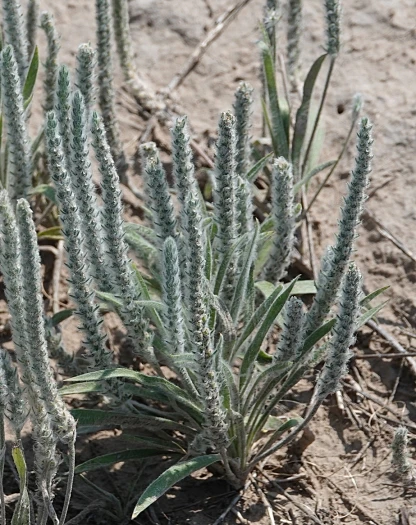Woolly Plantain
(Plantago patagonica)
Woolly Plantain (Plantago patagonica)
/
/

Colin Croft
CC BY 4.0
Image By:
Colin Croft
Recorded By:
Copyright:
CC BY 4.0
Copyright Notice:
Photo by: Colin Croft | License Type: CC BY 4.0 | License URL: http://creativecommons.org/licenses/by/4.0/ | Rights Holder: Colin Croft | Publisher: iNaturalist | Date Created: 2019-07-28T14:20:49-07:00 |



















Estimated Native Range
Climate Requirements for Bloomington, California
| This Plant | Your Site | Plant Suitability for Your Location | ||
|---|---|---|---|---|
| • Precipitation | 3" - 82" | 13" | You should be able to grow this plant with no additional irrigation. | Excellent |
| • High Temp. | 56°F - 110°F | 95°F | Your summer temperatures are normal for this plant. | Excellent |
| • Low Temp. | -8°F - 52°F | 41°F | Your winter temperatures are normal for this plant | Excellent |
This plant should grow very well at your location without additional irrigation.
Summary
Plantago patagonica, commonly known as woolly plantain, is a perennial herb native to a variety of habitats including grasslands, open woodlands, and prairies across North America, which encompasses southern Canada, the western and central United States, and northern Mexico, as well as extending into parts of South America. It typically produces a rosette of linear or narrowly lance-shaped basal leaves that can reach up to 4 inches in length. The leaves are often covered in fine hairs, giving the plant a woolly appearance. Woolly plantain blooms from late spring to early summer, with inconspicuous flowers that are wind-pollinated.
Woolly plantain is valued for its drought tolerance and ability to thrive in poor, compacted soils, making it a suitable choice for restoration projects and xeriscaping. It is also used in traditional medicine for its purported health benefits. In cultivation, it requires minimal care, thriving in full sun to part shade and in well-drained soils. While it is not typically grown for ornamental purposes, its resilience makes it a practical ground cover in challenging environments. Gardeners should be cautious, as Plantago patagonica can become invasive outside its native range, particularly in similar dry habitats.CC BY-SA 4.0
Woolly plantain is valued for its drought tolerance and ability to thrive in poor, compacted soils, making it a suitable choice for restoration projects and xeriscaping. It is also used in traditional medicine for its purported health benefits. In cultivation, it requires minimal care, thriving in full sun to part shade and in well-drained soils. While it is not typically grown for ornamental purposes, its resilience makes it a practical ground cover in challenging environments. Gardeners should be cautious, as Plantago patagonica can become invasive outside its native range, particularly in similar dry habitats.CC BY-SA 4.0
Plant Description
- Plant Type: Herb
- Height: 0.5-1.5 feet
- Width: 0.5-1 feet
- Growth Rate: Moderate
- Flower Color: N/A
- Flowering Season: Spring, Summer
- Leaf Retention:
Growth Requirements
- Sun: Full Sun, Part Shade
- Water: Low
- Drainage: Fast, Medium, Slow
Common Uses
Drought Tolerant, Erosion Control, Low Maintenance
Natural Habitat
Grasslands, open woodlands, and prairies
Other Names
Common Names: Patagonian Plantain, Woolly Indianwheat, Woolly Plantain, Patagonia Indian-Wheat, Patagonia Plantain, Pursh’s Plantain
Scientific Names: Plantago patagonica, Plantago candicans, Plantago canescens, Plantago gnaphalioides, Plantago gnaphaloides, Plantago ignota, Plantago limarensis, Plantago oblonga, Plantago patagonica f. glabrescens
GBIF Accepted Name: Plantago patagonica